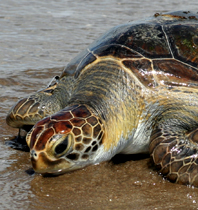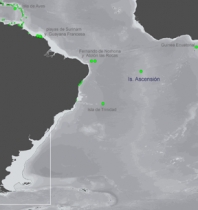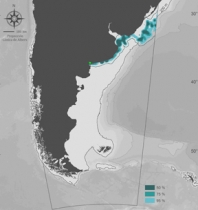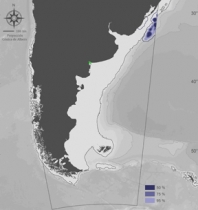|
 |
 | Green Turtle (Chelonia mydas).  |
 |
Regional Nesting Sites of the Green Turtle (Chelonia mydas).
References. Green dots: nesting sites. Blue text: populations for which the Atlas provides distribution data.
| © Ignacio Bruno |
 |
Nesting Sites |
 Principal feeding areas Principal feeding areas |
Green turtles make intense use of the coastal waters of the Buenos Aires Province, Uruguay and southern Brazil, and to a small extent, the deep waters on the continental slope. The saline fronts of the Rio de la Plata, Bahia de San Borombon and the estuary of Bahia Blanca, were areas of great importance year round for the small sample of individuals tracked.
Data on 3 juveniles of green turtle satellite-tracked, unknown sexes, marked at the estuary of Bahia Blanca (Buenos Aires Province, Argentina). Period: January-December.
Dataholders: V. González Carman and D.A. Albareda.
 |  Spring Spring |
During spring, green turtles use principally the warm waters on the continental slope in front of Uruguay and South Brazil.
Data on 3 juveniles of green turtle satellite-tracked, unknown sexes, marked at the estuary of Bahia Blanca (Buenos Aires Province, Argentina). Period: October-December.
Dataholders: V. González Carman and D.A. Albareda.
 Summer Summer |
During summer, green turtles usecoastal waters closer to Buenos Aires and Uruguay, principally thesaline front of the Rio de la Plata.
Data on 3 juveniles of green turtle satellite-tracked, unknown sexes, marked at the estuary of Bahia Blanca (Buenos Aires Province, Argentina). Period: January-March.
Dataholders: V. González Carman and D.A. Albareda.
 |  Autumn Autumn |
In autumn, when the sea temperature descends, turtles migrate to the warm waters of southern Brazil, even though the saline front of the Rio de la Plata continues to be important.
Data on 3 juveniles of green turtle satellite-tracked, unknown sexes, marked at the estuary of Bahia Blanca (Buenos Aires Province, Argentina). Period: April-June.
Dataholders: V. González Carman and D.A. Albareda.
 |
In winter, the distribution extends to the North, with particular use of the warm waters on the slope associated with the Brazil Current.
Data on 3 juveniles of green turtle satellite-tracked, unknown sexes, marked at the estuary of Bahia Blanca (Buenos Aires Province, Argentina). Period: July-September.
Dataholders: V. González Carman and D.A. Albareda.
 | |
|
 |
Green Turtle
Chelonia mydas
Regional Nesting Sites: The species has a circumglobal distribution, occurring throughout tropical and subtropical waters. Green turtles are highly migratory and can be found in the temperate waters of the South West Atlantic although nesting sites do not occur in nearby areas. Genetic analyses show that green turtles in the Patagonian Sea come mainly from Ascension Island (Atlantic Ocean, midway between South America and Africa) and probably from the coast of Surinam and Aves Island (remote island in the Caribbean Sea). More than 590 nesting sites have being recorded for the Caribbean, Brazil and Bermudas. Diet: Pelagic green turtles are omnivorous, but in neritic waters of the continental shelf they shift to benthic foraging and feed on seagrasses and algae. The importance of jellyfish in the diet of turtles that visit the Patagonian Sea is now being evaluated. World breeding population: Estimated at 2.2 – 2.6 millions. Conservation Status: Endangered (IUCN, 2010). Main threats: Green turtles are exposed to anthropogenic impacts during all life-stages: intentional harvest of eggs, nesting habitat degradation (construction of buildings, artificial lights on nesting beaches, sand extraction), pollution and diseases. Bycatch and entanglement in marine fisheries are primary threats for juveniles and adults.

|

